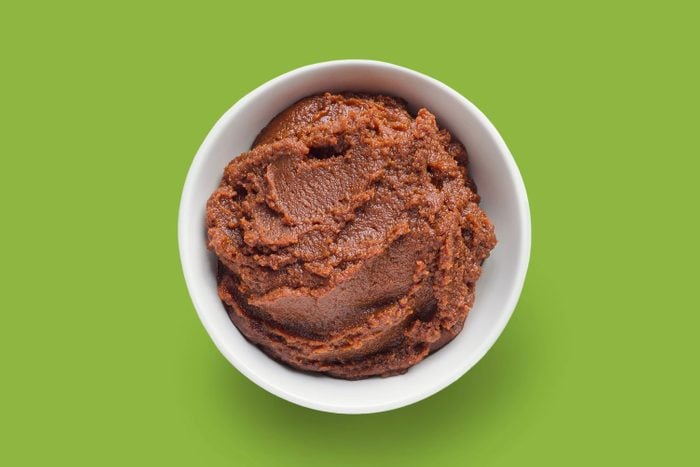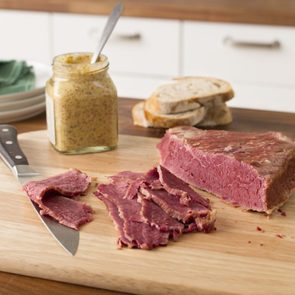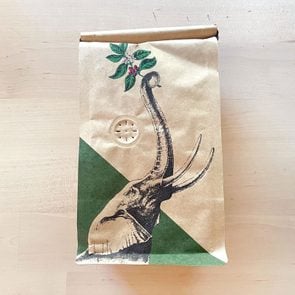What Is Miso, Exactly?
Updated: Feb. 08, 2023

A short guide to miso, the savory Japanese ingredient that'll punch up the flavor of your favorite dishes
My friend’s excited voice on the phone could only mean one thing: She had found another obscure (for her) ingredient in the new international food store that had opened up near her place. I wasn’t wrong. “What is miso?” she asked excitedly.
Since I’m the go-to person in our little circle for this kind of information, I was speaking to her a lot lately. Not that I minded. I love food. I love talking about food. I love watching someone experience a new food for the first time. So I filled her in, explaining that miso is a pungent, good-for-you paste made from fermented soybeans. The word miso literally means “fermented beans” in Japanese, and it’s a staple of Japanese cooking. That fragrant soup served alongside wasabi-laced sushi and sashimi at your local Japanese restaurant? Yep, it has miso.
If you’re interested in more food facts and trivia, keep reading for a primer on what miso is and how it’s used.
Get Reader’s Digest’s Read Up newsletter for more food facts, humor, cleaning, travel, tech and fun facts all week long.
What is miso paste?
Miso is a richly flavored paste made from fermented soybeans, which are then mixed with salt and koji, the same mold used to make sake, a beloved Japanese alcoholic beverage made from fermented rice. Miso may also contain barley, rye, rice or other grains.
It’s a staple in Japanese cooking, and for those of us who live outside Japan, miso soup is probably its most widely known use. But it’s also used in sauces, dressings and marinades. Add a tablespoon of it to tofu, rice, scrambled eggs, veggies or noodles, and you’ll transform your dish to a palate-pleaser filled with umami goodness. You can even use miso to pickle vegetables and meats!
What is miso soup?
Miso paste is an ideal base for soups, stocks, stews and sauces because it’s easily diluted in water. And there’s no better introduction to the ingredient than a steaming bowl of miso soup.
So, what is miso soup made of? In traditional miso soup, softened miso paste is mixed with dashi stock, a type of fish broth. Then, per Japanese custom, other ingredients are added to reflect the seasons as well as to provide contrasting colors, textures and flavors. Try making your own by adding shrimp, fish, seaweed, potatoes, tofu, scallions or green onions, clams, daikon or taro. Just avoid using watered-down packets of miso soup; by making your own base from miso paste, you’ll get the superior taste and comfort of authentic miso soup.
What does miso taste like?
The different grains used to make miso and how long the paste ages play a role in the look and taste of miso paste. People generally expect miso to taste salty without realizing that some miso is somewhat sweet and mild. It all depends on the type of miso paste you use.
Shop at your local Asian grocery, and you’ll probably come across a few different types of miso. What is miso going to taste like based on the type you use? Here’s what you need to know:
- Red miso: Made from soybeans, barley and other grains, this miso (also called aka miso) is aged for a long time and tastes intensely savory.
- White miso: Known as shiro miso, this paste is primarily made from soybeans and rice. It’s fermented for far less time than red miso, so it has a much more delicate and mildly sweet taste.
- Yellow miso: With a flavor falling somewhere between red and white miso, this paste (also called shinsu miso) appears anywhere from light yellow to light brown.
- Awase miso: Particularly versatile in recipes, this type of miso is a combination of red and white miso.
What can I substitute for miso?
Although it is difficult to find a perfect substitute for miso paste, soy sauce is the best alternative because it can stand in for the salty and savory taste of miso in most recipes. Or try fish sauce, another salty Japanese staple with an even stronger flavor.
According to Sonja and Alex Overhiser of the recipe site A Couple Cooks, you can substitute half a tablespoon of soy sauce or half a teaspoon of fish sauce for one tablespoon of miso paste.
Is miso vegan?
Miso paste is generally considered vegan, but the same doesn’t necessarily hold true for miso soup. That’s because miso soup often includes ingredients like fish, shrimp, clams and other seafood. That said, you can whip up your own vegan miso soup by using tofu, vegetables and ramen noodles instead of fish.
Is miso healthy?
What is miso beyond the savory ingredient your favorite dishes have been waiting for? Good for your gut, actually. Because it’s made from fermented soybeans, miso paste contains probiotics, the good-for-you bacteria that can improve digestive health. That said, miso paste is pretty high in sodium—a tablespoon can have close to 1,000 milligrams!—so pay attention to how much you’re eating, especially if you have high blood pressure.
If all this talk of miso’s saltiness is making you thirsty, you can wash down your savory dishes with some sweet sips: Both chai tea and bubble tea pair well, giving you a deliciously sweet-and-salty meal to remember.
Source:
- A Couple Cooks: “Best Miso Substitute”



























